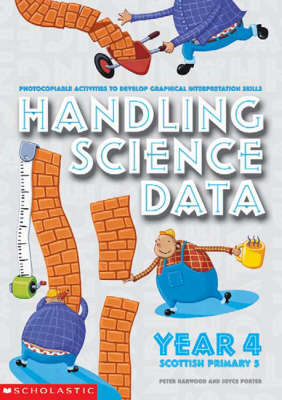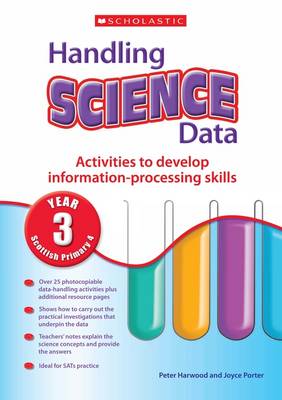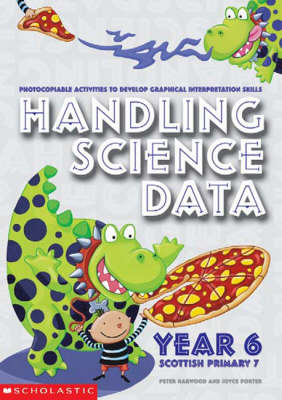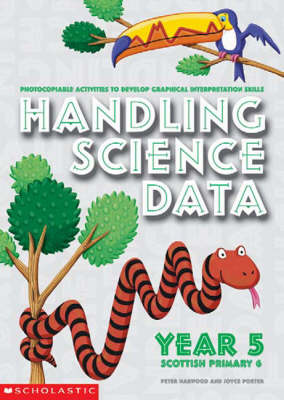Handling Science Data
4 total works
Children consistently struggle in the science national tests when they asked to explain data presented as tables of results or graphs. The skills needed to understand and use such data must be developed throughout the primary years. This series is aimed at teachers of KS2/Primary 4-7. It comprises of four year-specific books of 64 pages each. Each book provide paired pages: pupils' photocopiable worksheets presenting some science data (in a form appropriate to the mathematical development of children of that age) with interrogation questions, and teachers' notes explaining how to obtain similar data, the key features of the data presentation given and the answers to the questions on the pupil's page. Each book will include activities relating to living things, materials and physical processes. The topics to which the data relates will be drawn from the "QCA Science Scheme of Work", but with references to show their application in Scotland, for example, and including one or two data sets in each book to cover the occasional topics that only occur in the Scottish curriculum, such as energy.
The data presented in these books is real work by Year 3-6 children, collected for the Liverpool John Moores University Primary Science Project, sponsored by the Astra Zeneca Science Teaching Trust.
The data presented in these books is real work by Year 3-6 children, collected for the Liverpool John Moores University Primary Science Project, sponsored by the Astra Zeneca Science Teaching Trust.
Children consistently struggle in the science national tests when they asked to explain data presented as tables of results or graphs. The skills needed to understand and use such data must be developed throughout the primary years. This series is aimed at teachers of KS2/Primary 4-7. It comprises of four year-specific books of 64 pages each. Each book provide paired pages: pupils' photocopiable worksheets presenting some science data (in a form appropriate to the mathematical development of children of that age) with interrogation questions, and teachers' notes explaining how to obtain similar data, the key features of the data presentation given and the answers to the questions on the pupil's page. Each book will include activities relating to living things, materials and physical processes. The topics to which the data relates will be drawn from the "QCA Science Scheme of Work", but with references to show their application in Scotland, for example, and including one or two data sets in each book to cover the occasional topics that only occur in the Scottish curriculum, such as energy.
The data presented in these books is real work by Year 3-6 children, collected for the Liverpool John Moores University Primary Science Project, sponsored by the Astra Zeneca Science Teaching Trust.
The data presented in these books is real work by Year 3-6 children, collected for the Liverpool John Moores University Primary Science Project, sponsored by the Astra Zeneca Science Teaching Trust.
Children consistently struggle in the science national tests when asked to explain data presented as tables of results or graphs. The skills needed to understand and use such data must be developed throughout the primary years. This series is aimed at teachers of KS2/Primary 4-7. It comprisesof four year-specific books of 64 pages each. Each book provides paired pages:pupils' photocopiable worksheets presenting some science data (in a form appropriate to the mathematical development of children of that age) with interrogation questions, and teachers' notes on explaining how to obtain similar data, the key features of the data presentation given and the answers to the questions on the pupil's page. Each book will include activities relating to living things, materials and physical processes. The topics to which the data relates will be drawn from the QCA Science Scheme of Work, but with references to show their application in Scotland, for example, and including one or two data sets in each book to cover the occasional topics that only occur in the Scottish curriculum, such as energy.
The data presented in these books is real work by Year 3-6 children, collected for the Liverpool John Moores University Primary Science Project, sponsored by the Astra Zeneca Science Teaching Trust.
The data presented in these books is real work by Year 3-6 children, collected for the Liverpool John Moores University Primary Science Project, sponsored by the Astra Zeneca Science Teaching Trust.
Children consistently struggle in the science national tests when they asked to explain data presented as tables of results or graphs. The skills needed to understand and use such data must be developed throughout the primary years. This series is aimed at teachers of KS2/Primary 4-7. It comprises of four year-specific books of 64 pages each. Each book provide paired pages: pupils' photocopiable worksheets presenting some science data (in a form appropriate to the mathematical development of children of that age) with interrogation questions, and teachers' notes explaining how to obtain similar data, the key features of the data presentation given and the answers to the questions on the pupil's page. Each book will include activities relating to living things, materials and physical processes. The topics to which the data relates will be drawn from the "QCA Science Scheme of Work", but with references to show their application in Scotland, for example, and including one or two data sets in each book to cover the occasional topics that only occur in the Scottish curriculum, such as energy.
The data presented in these books is real work by Year 3-6 children, collected for the Liverpool John Moores University Primary Science Project, sponsored by the Astra Zeneca Science Teaching Trust.
The data presented in these books is real work by Year 3-6 children, collected for the Liverpool John Moores University Primary Science Project, sponsored by the Astra Zeneca Science Teaching Trust.



